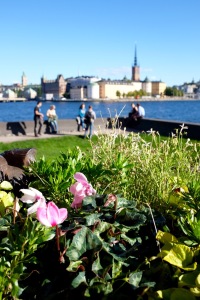Two of the most distinctive features of Stockholm’s skyline are the spires of Riddarholmskyrkan (Knights Isle Church) and Stadshuset (City Hall). Built nearly 7 centuries apart, the towers face off on opposite shores of the Riddarfjärden channel; they are similar in scale (280 and 350 feet respectively) and substance (both set in dark red Swedish brick), but cast very different shadows over the city and its history. The longer we’re here, the more enchanting their mismatched love affair seems to me.
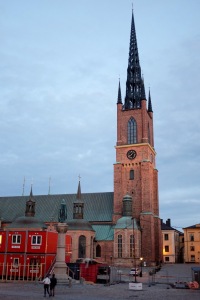
Riddarholmskyrkan may be the oldest building in Stockholm. King Magnus Ladulås sponsored its construction as a Franciscan monastery in the 13th century, and is thought to be buried there; its royal affiliation made it one of the only churches to to survive the Protestant Reformation, when it was converted for use by the Swedish Lutheran church. Eventually the floor became a chessboard of tombs spanning 750 years, the original footprint built out with new dynastic chapels.
Gustaf II Adolf formally appointed Riddarholmskyrkan the Royal Burial Church before his own death in 1634, and built its first extension, the Gustavian chapel (righthand spire, below), to hold his remains. 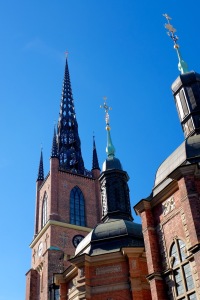 The iconic cast iron steeple (lefthand spire) was a fire-resistant addition after lightning destroyed the church roof in 1835; the ceremonial bell was recast from the original damaged bronze. The most recent addition, the Bernadotte chapel (center spire), was completed in 1860, and laid to rest every royal family member through Gustaf V in 1950.
The iconic cast iron steeple (lefthand spire) was a fire-resistant addition after lightning destroyed the church roof in 1835; the ceremonial bell was recast from the original damaged bronze. The most recent addition, the Bernadotte chapel (center spire), was completed in 1860, and laid to rest every royal family member through Gustaf V in 1950.
The church dissolved its congregation over 200 years ago, and since the 1950’s the royal family uses the more spacious Haga Park cemetery on the northwest end of town. But the bell still rings a full hour when any member of the Kungliga Serafimerorden (Order of the Seraphim), Sweden’s chivalric system, passes away; (relatively) recent ceremonies celebrated Gustaf VI Adolf, Sweden’s royal professional amateur professor (1973); Haile Selassie, the Rastafarian messiah (1975); and Nelson Mandela, Father of the Nation for South Africa (2013).
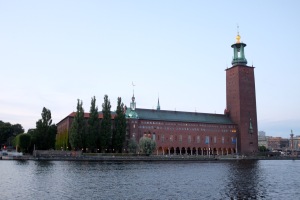
By 1907, political authority in Sweden had shifted away from the monarchy; the Torekov compromise would make it entirely ceremonial. The new Stadshuset (City Hall) provided a landmark for the modern era, intended both to house Stockholm’s Kommunfullmäktige (Municipal Council) and to revitalize the industrial economy. The massive undertaking employed hundreds of on-site engineers, craftsmen, and artists, and took 12 years; despite initial protests at the expense, it has been celebrated since its 1923 completion as an exemplar of Swedish byggnadshyttan (akin to the Bauhaus movement) and the National Romantic style, the self-consciously Scandinavian response to Art Nouveau.
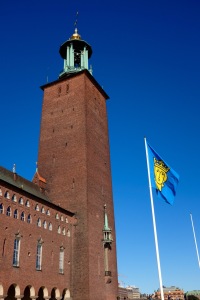 For me, the appeal of Stadshuset’s enormous square tower—almost unbroken by texture, ornament, or even windows—is difficult to grasp. The smooth facade and stark properties distinguish it dramatically from the more classical style of older Stockholm landmarks, harkening instead to Nordic stave churches and the presumed aesthetic of the Viking Age. I find Riddarholmskyrkan tower much easier on the eyes (but I suppose I’ll never be a Swedish nationalist).
For me, the appeal of Stadshuset’s enormous square tower—almost unbroken by texture, ornament, or even windows—is difficult to grasp. The smooth facade and stark properties distinguish it dramatically from the more classical style of older Stockholm landmarks, harkening instead to Nordic stave churches and the presumed aesthetic of the Viking Age. I find Riddarholmskyrkan tower much easier on the eyes (but I suppose I’ll never be a Swedish nationalist).
The tower notwithstanding, Stadhuset’s interior is a unique synthesis of motifs, Italian to Byzantine and classical to modern, all adapted to the iconography of Swedish history. The famous 150-foot Golden Hall, covered in 18 million gold tiles, is as stunning as it sounds—including self-referential mosaics depicting both Riddarholmskyrkan and Stadshuset’s own tower.
The Stadshuskällaren restaurant hosts the Nobel Banquet each December; with a little planning (and investment) you can book your own tasting of any Nobel menu from the past century.
Paved in flat stones from the Stockholm archipelago, the tranquil Stadshuset gardens are an oasis in full view of busy Central Station and Gamla Stan.
Not to be outdone by its sister tower’s pantheon of tombs, Stadhuset was meant to house the remains of Birger Jarl, Sweden’s 13th-century Jarlen som byggde riket (Earl-who-built-the-kingdom). But architect Ragnar Östberg was evidently overruled, and Birger stayed at Varnhem Abbey, 200 miles west. The golden cenotaph at the eastern base of the tower stands empty, casting a hollow gaze over the water—and centuries—towards Riddarholmen.

